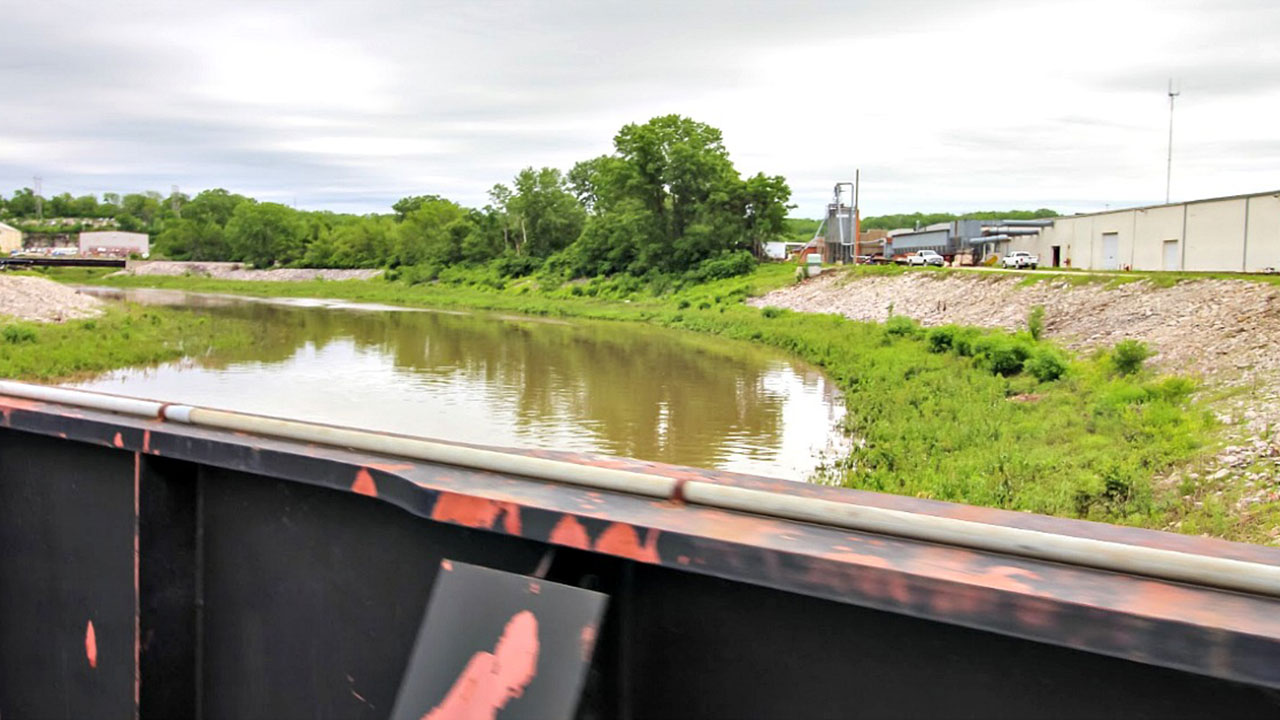Flooding is Front and Center
When industrial operations first emerged along the Blue River a century ago, flooding arrived along with them and became part of the price of doing business by the river. It’s hard to imagine how companies kept going before the $300 million Blue River Channel Project came into play in the 1960s. The flood control initiative took a lot of creative problem-solving and about three decades to complete. The result is a massive improvement that created substantially more capacity to keep rising water within the banks of the River.
Thanks to flood control, FEMA’S 100-year floodplain map of the BRVIC has shrunk to just 1,500 acres or about a third of the Corridor’s total size. Many northern properties within the Corridor have greatly benefited but other properties still remain in the floodplain. Local authorities continue to work on economic development initiatives to improve conditions in the area.

The Blue River winds through the Blue River Valley Industrial Corridor from the Missouri River south to the Truman Sports Complex. Photo courtesy: EDCKC.
Complex soil and water properties are fundamental factors to consider when developing property in the BRVIC. Land in and around the floodplain requires extensive evaluation before development can begin. The most important part of due diligence is to consult with a geotechnical engineer because findings from the initial investigation, and subsequent investigations, will likely impact site designs, construction costs, and utility plans.
Respect the Slope
‘Do not disturb’ is a smart strategy when working with land near a river. If you’re building near the Blue River, think carefully about how much you want to disturb the river’s slope. Slope stability is the ability of inclined soil to withstand movement. Too much digging can threaten its stability and invite erosion of nearby structures.
Extensive excavation and large amounts of fill soil may not be a good option, especially if the slope is steep. And, the steeper the slope, the more likely a retaining wall will be part of the final site plan.

A layer of rocks helps fortify sections of land along the banks of the Blue River.
Beware of Buoyancy
When you push an empty bottle into a bucket of water, the water tends to push the bottle back up. Simply put, that’s a buoyancy force at work. Water that seeps into the soil can have the same effect. A river can saturate the surrounding soil underground to create buoyancy forces that impact construction. The bigger the river, the bigger the force, as we discovered while working with Evergy along the Missouri River. The Blue River may be smaller but it shouldn’t be underestimated.
Knowing how close to the Blue River you can safely build depends on the soil profile in the area. Investigating surface and subsurface conditions, and groundwater levels is critical in determining whether buoyancy forces or other issues will impact project plans. You’ll want the help of geotechnical engineers who can perform a comprehensive analysis that considers a variety of factors like seasonal fluctuations in groundwater conditions along a river.
Proper assessment of buoyancy forces pinpoints the critical balance between a building and the ground beneath it. The downward gravitational force of the structure must be stronger than the upward buoyancy force. Geotechnical engineers can help ensure the right calculations and adjustments for keeping your structure firmly in place.
Experience Brings Progress
Skipping the geotechnical investigation of land in the BRVIC is an invitation for trouble. The importance of having an accurate geotechnical report when working in the BRVIC cannot be overstated! Ideally, you want to understand the costs and risks of your project ahead of time, and collaborating with an experienced geotechnical engineer who knows the area well is the best way to avoid problems and plan.
Our team has decades of experience developing industrial and brownfield properties and we have extensive local knowledge of the land above and below the Blue River Valley Industrial Corridor.

Read about our ongoing work with Custom Truck One Source in the BRVIC >>
See how we helped Evergy counter river forces at the Hawthorne Generation Station >>



